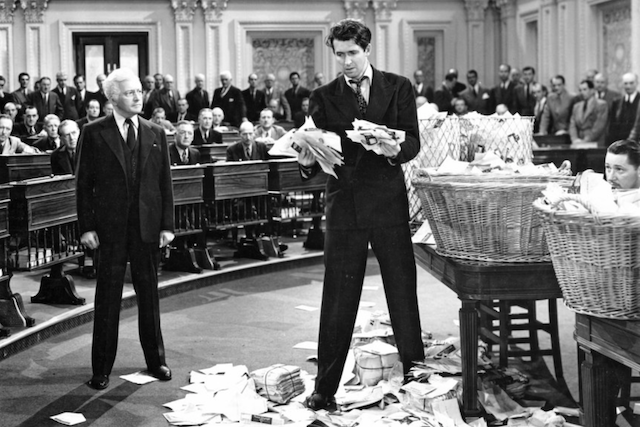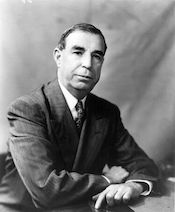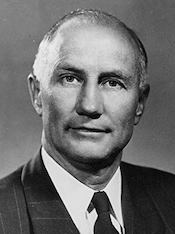While the filibuster started as a measure to protect the voices of a minority, more recently it has been used in quite literally the opposite way: to protect entrenched and powerful forces.
 The most famous filibuster in American history is a fictional one. In Frank Capra’s 1939 film Mr. Smith Goes to Washington, Jimmy Stewart is Senator Jefferson Smith, a Washington outsider who has unwittingly been used and then betrayed by his late father’s friend, the powerful and corrupt Senator Joseph Paine (Claude Rains). In the stirring climax, Senator Smith filibusters for more than a full day, to the point of absolute exhaustion, in order to stand up for himself and challenge Paine’s crooked plans. Smith’s filibuster is a tribute to American ideals, but even more than that it represents an idealized vision of the filibuster itself, as a way in which the little guy can resist and eventually triumph over the Senate and U.S. government’s most powerful forces.
The most famous filibuster in American history is a fictional one. In Frank Capra’s 1939 film Mr. Smith Goes to Washington, Jimmy Stewart is Senator Jefferson Smith, a Washington outsider who has unwittingly been used and then betrayed by his late father’s friend, the powerful and corrupt Senator Joseph Paine (Claude Rains). In the stirring climax, Senator Smith filibusters for more than a full day, to the point of absolute exhaustion, in order to stand up for himself and challenge Paine’s crooked plans. Smith’s filibuster is a tribute to American ideals, but even more than that it represents an idealized vision of the filibuster itself, as a way in which the little guy can resist and eventually triumph over the Senate and U.S. government’s most powerful forces.

Vice President, Aaron Burr
That is indeed the ideal way in which this Senate measure protecting the voices and rights of a minority can be used. But across the filibuster’s history, and particularly as it became more frequently utilized in the mid- to late-20th century, it has been consistently used in quite literally the opposite way: to protect entrenched and powerful forces against challenges and changes. Understanding that consistent historical use is crucial if we’re going to have an informed and productive conversation about the role and limits of the filibuster in our 21st century.
The U.S. Senate describes a filibuster as “a loosely defined term for action designed to prolong debate and delay or prevent a vote on a bill, resolution, amendment, or other debatable question.” The filibuster isn’t one of the Senate rules or Congressional procedures outlined in the Constitution, and beginning in 1789 the first Senate operated with a rule that a simple majority vote was necessary to “move the previous question” and end debate on a bill. During his time as Vice President, Aaron Burr critiqued this rule, and in 1806 the Senate agreed, ending the process and making it possible for something like the filibuster to keep debate open indefinitely. That began to happen in the late 1830s and early 1840s, including an 1837 filibuster by Whig senators who opposed Andrew Jackson and sought to keep open a debate over censuring him, and an 1841 filibuster by Senator Henry Clay of a bill for a new national bank.

Henry Clay
Such individual filibusters were few and far between until well into the 20th century. In 1917, President Woodrow Wilson convinced the Senate to adopt a new rule, known as cloture, by which a vote of two-thirds of senators could end debate on any bill. Perhaps in response to this change, and perhaps because of increased media visibility, individual senators began to use the filibuster more regularly to challenge policies and advance their own agendas. The most prominent such filibustering senator was Louisiana’s populist demagogue and former Governor Huey Long, who conducted multiple filibusters during his brief time in the Senate (he was senator from 1932 until his 1935 assassination). Although Long was quite powerful by this time in his home state, his opposition to New Deal policies was certainly unpopular with fellow Democrats, and so he could be said to be challenging dominant forces through his filibusters.

Huey Long (Library of Congress)
As other senators, and particularly other conservative southern Democrats, began to use the filibuster more regularly, they did so directly in service of entrenched powerful forces, including white supremacy. In 1946, progressive New Mexico Senator Dennis Chávez introduced a bill to make permanent President Roosevelt’s World War II-era Fair Employment Practice Committee (FEPC), a federal government entity which had since its 1941 creation sought to help minorities obtain wartime jobs and to address and challenge workplace discrimination more broadly. Chávez had the votes to pass his bill, but five conservative southern Democratic senators — Louisiana’s John H. Overton, Georgia’s Richard B. Russell, Maryland’s Millard E. Tydings, North Carolina’s Clyde R. Hoey, and Tennessee’s Kenneth McKellar — filibustered for weeks, eventually forcing Chávez to withdraw the bill.

Dennis Chávez (Library of Congress)
That 1946 effort became the playbook for southern Democrats and other conservative senators seeking to oppose anti-discrimination and other civil rights legislation. In 1957, South Carolina Senator Strom Thurmond set a new record for the longest filibuster, speaking for more than 24 hours in opposition to the Civil Rights Act of 1957 (which would guarantee federal protection for African American voters). Thurmond did so in large part by appealing to some of American history’s most powerful and iconic texts, reading the entirety of the Declaration of Independence, the Bill of Rights, and George Washington’s farewell address. Thurmond eventually tired and ended his filibuster and the law passed, if with a number of its most important measures removed or limited (such as the power of federal judges to enforce the law).

Strom Thurmond
Less than a decade later, a group known as the “Southern Bloc,” featuring 18 southern Democrats and Texas Republican John Tower, shattered Thurmond’s record, filibustering the Civil Rights Act of 1964 for more than 80 days. West Virginia Senator Robert Byrd alone filibustered for more than 14 hours in one speech, and he was joined by all these colleagues who were determined, as Georgia Senator Richard Russell put it, to “resist to the bitter end any measure or any movement which would tend to bring about social equality and intermingling and amalgamation of the races in our states.” After countless back and forth debates and changes over these 80-plus days, Senate Whip Hubert Humphrey determined correctly that he had enough votes for cloture; by a 71-29 vote the cloture motion passed on June 10, and on June 19 the Senate passed the compromised but still hugely important bill that became the Civil Rights Act.
The fact that the 1957 and 1964 Civil Rights Acts eventually passed cannot, however, obscure the way in which conservative opponents used the filibuster to challenge, delay, and even alter these vital pieces of legislation, in service of maintaining entrenched power and white supremacy. In so doing, they were very much in keeping with the filibuster’s 20th century development, use, and legacy. In the 21st century, that legacy has become even more extreme, as the current filibuster no longer even requires speeches or other continual use of the Senate floor; individuals in a minority party can simply record their objection and a bill cannot be brought to a vote without the 2/3 majority necessary to achieve cloture. As Robert Byrd himself noted about this change, “Now, unbelievably, just a whisper of opposition brings the ‘world’s greatest deliberative body’ to a grinding halt.”
Too often, our current debates over the filibuster not only ignore but overtly mischaracterize these histories. Joe Manchin claimed that the filibuster has been “the tradition of the Senate for 232 years,” while Kyrsten Sinema called the filibuster a defense against “partisanship.” As the Senate, President Joe Biden, and others continue to debate whether the filibuster can or should continue to exist at all, it’s incumbent on all of us to challenge these inaccuracies and myths, and to engage instead with both the specific histories and the overarching role through which the filibuster has long served as a tool of entrenched powerful interests.
This series by American studies professor Ben Railton explores the connections between America’s past and present.
Written by Ben Railton for The Saturday Evening Post ~ January 14, 2022
